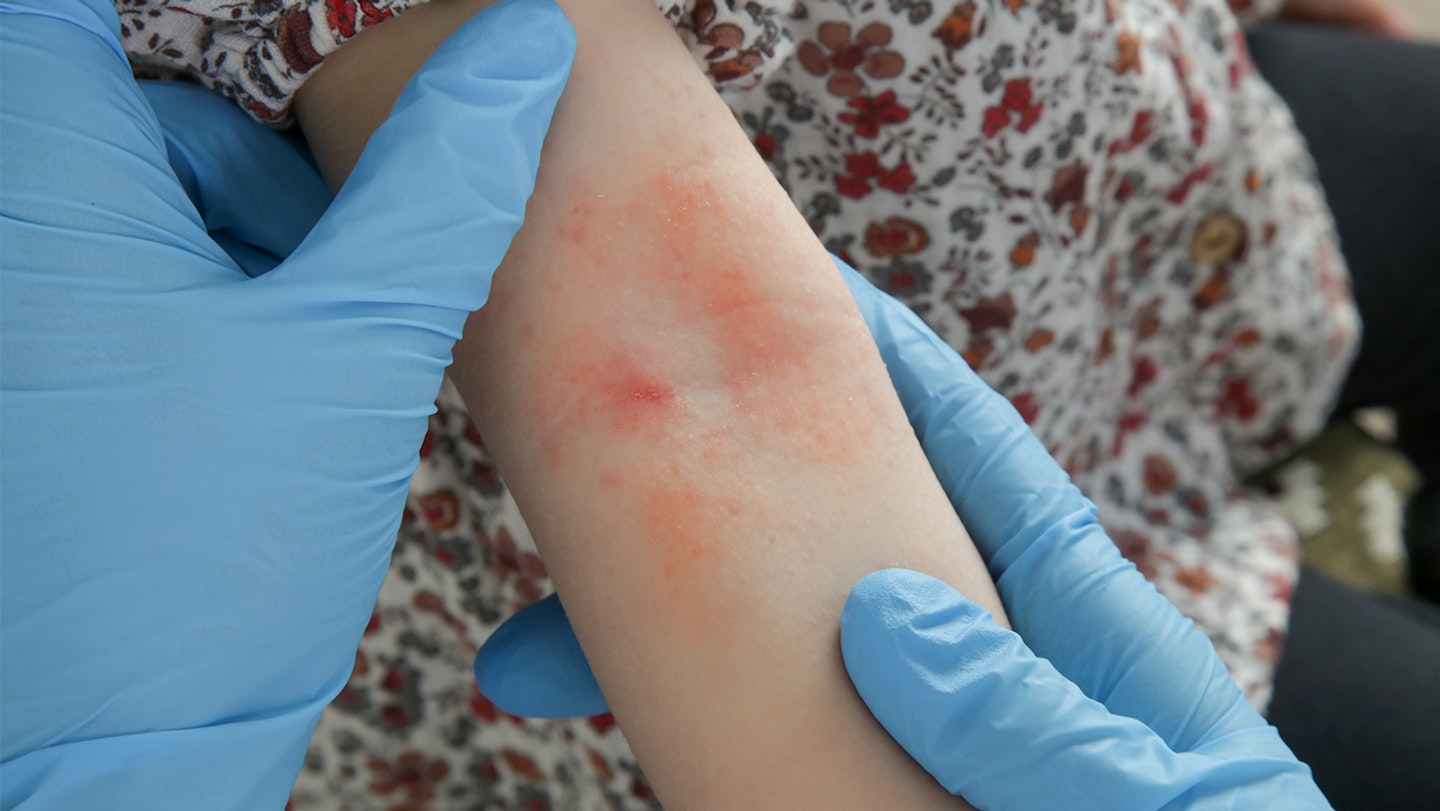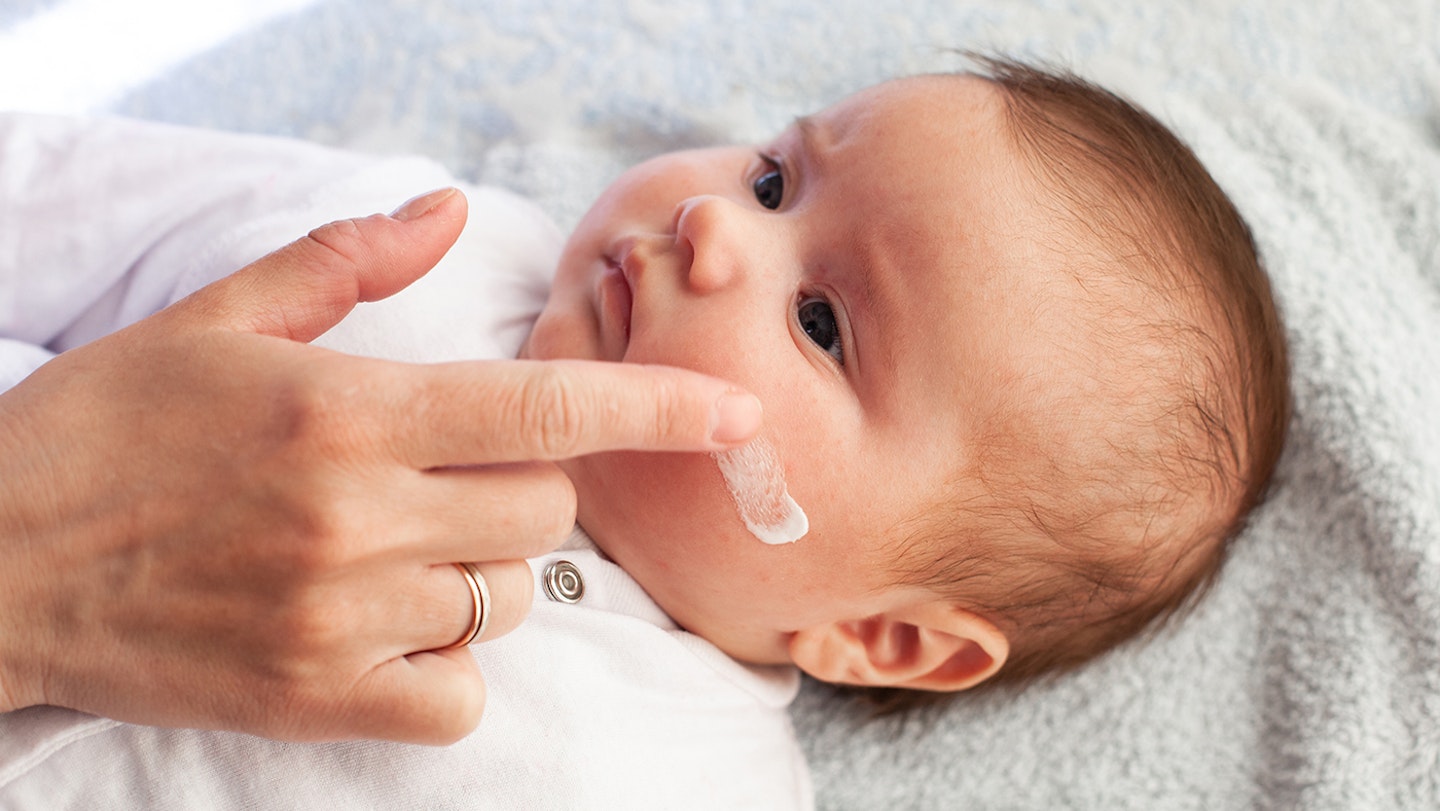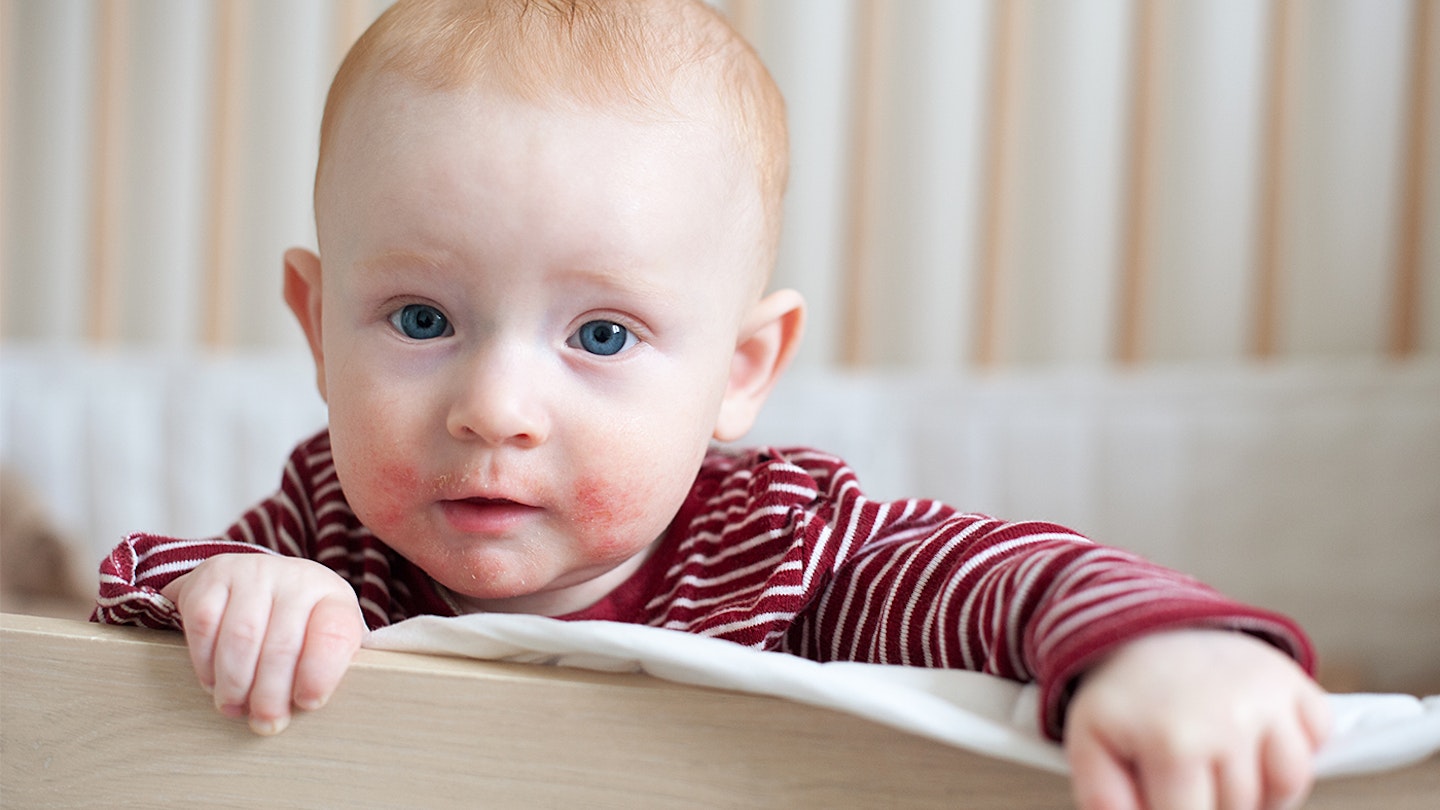Your baby's skin is like a blanket - so soft to touch and there to cocoon and protect them from the outside elements. And yet, of course, not all baby skin is so seemingly perfect - in the early months alone, your little one could face the likes of newborn skin peeling and milk spots – and that’s what’s considered normal! Another common skin condition is baby eczema, which affects a fifth of children in the UK.
The term eczema comes from the Greek word, ‘ekzein’, which means to boil, and with symptoms including dry, scaly, red or brown rash depending on your child's skin pigmentation and itchy skin, it’s easy to understand why it’s got its strange name. But don’t be alarmed. "The good news is that roughly 60 per cent of children will grow out of eczema by school age, 80 per cent by secondary school age and just 10 per cent will go on to have eczema into adulthood," says Dr Jess Felton, a paediatric dermatologist. One of the ways you can help increase your child’s chances of outgrowing eczema is to get it under control now.
What is baby eczema?
When you first hold your baby, you feel just how delicate they, and their skin, are. "A newborn baby’s skin is especially vulnerable in the first two weeks while they become accustomed to life outside the womb," says Jess. "The function of skin as a barrier is reduced in early infancy." This means it’s more susceptible to environmental triggers, such as dust mites, pollen, furry pets and cold winter weather. They're also at risk from the likes of viral infections, teething symptoms and stress, which can all cause flare-ups.
"These can cause skin to look dry and inflamed, and it’s most likely to be itchy," says Dr Jennifer Crawley."It’s commonly found in the creases behind the knees, of the elbows, and neck – and on the face."
There are two main types of baby eczema baby's can experience:
Atopic dermatitis: Most common amongst babies with a family history of eczema and allergies and is a chronic condition.
Contact dermatitis: Develops when their skin comes in contact with an irritating substance and usually clears up once the irritant has been removed.
The symptoms: What does baby eczema look like?
The very first signs of eczema will be intense itching with a dry rash appearing later. The colour of the rash can vary depending on your child's skin tone.
Lighter pigmented skin: For babies with paler skin tones, the rash can appear pink or red in colour.
Darker pigmented skin: For babies with darker skin tones, the rash can be a reddish brown shade or purple and grey and may be harder to spot. It's especially important for babies with darker skin tones who are suffering with eczema to seek treatment as they are more likely to experience hypo or hyperpigmentation on the area of skin where the eczema was.
It can occur all over the body but is most commonly found on hands, the insides of elbows, the backs of knees and the scalp and face. This is not to be confused with teething rash.
"Skin will be itchy and sometimes scaly or flaky," says Dr Mary Glover a paediatric dermatologist from Great Ormond Street Hospital. "You may notice your baby is extra wriggly, stops sleeping or is more irritable due to the discomfort."

What causes baby eczema?
While environmental factors and allergens that can affect baby can contribute to eczema development, in some cases there is also a genetic link. ‘In the last 10 years we have discovered a gene called filaggrin that is deficient in half of people with moderate to severe eczema,’ says Jess. "In this group, eczema is certainly hereditary and generally, an eczema tendency does run in families, but there are always exceptions."
However, your baby’s diet and the environment can trigger the condition too. "In some babies, exposure to foods such as milk, eggs and wheat will trigger the allergic reaction in your baby, causing eczema symptoms," says Professor Simon Murch from the Royal College of Paediatrics and Child Health.
Other eczema triggers include toiletries and washing powders that contain perfumes, sulphates – which make products foam – and preservatives, as well as dust and pet fur.
Build a barrier
Research has shown that children with the poorest skin barrier are at an increased risk of developing eczema so the priority for any parent, whether your baby is already showing signs of eczema or not, is to build the barrier and prevent allergens from penetrating the baby’s skin. While maintaining and protecting your baby’s skin barrier can help prevent eczema flare-ups, it could also have more far-reaching effects. Studies have shown that infants who develop eczema are more likely to develop food allergies, asthma and hay fever as they get older – a development that’s known as the atopic march.
"Cracks in the skin of those with eczema often set off a chain of allergic diseases that develop over several years," says Dr Donald Leung, head of Pediatric Allergy & Clinical Immunology at National Jewish Health. "Restoring the skin barrier as soon as eczema develops is the best way to stop the atopic march in its tracks and prevent allergic diseases from developing."
Treatment for baby eczema
The most reliable form of treatment is often a baby eczema cream. Like when preventing nappy rash, it's all about using a barrier cream or toddler lip balm to prevent rashes from developing. "To help prevent eczema, moisturise, moisturise, moisturise," says Jennifer. "Maintaining the skin barrier by applying lots of emollient is the mainstay of treatment. Hydrate your child's skin regularly – thicker ointments are better, particularly in the winter months when cold weather, dry air and central heating can all make eczema worse. Then lighter creams can be used in spring and summer months."
If you’ve got a wriggly toddler or a baby whose skin is sore, applying moisturisers daily is no mean feat, especially when areas of broken skin can sting when any cream is first applied. "Sometimes applying cream can become a battleground," acknowledges Jess. "Choosing one that’s comfortable for your child is really important. Cream can feel cold when applied and though this can be soothing to some children with eczema, younger children tend not to like this so warming up cream to skin temperature in your hands before applying it can help. Incorporating massage with the emollient as a wind-down routine before bed can be soothing too."

"Morning application can be trickier due to our busy lives so keep an emollient handy and link it to another activity, such as tooth brushing or nappy changing, to make it easier to become part of your routine rather than another thing to remember."
Natural remedies for baby eczema
Discourage itching
Eczema is seriously itchy, so you’ll need to do everything you can to stop your youngster scratching, so their skin has a chance to heal. Forget scratch mitts and opt for clothing with integrated mitts that they won’t be able to pull off when the urge to stop the itch hits. You should also ensure you keep their nails nice and short so they don't scratch their skin and make the rash worse.
When moisturiser is applied, the itch can get worse before it gets better. ‘Stopping your youngster from scratching their skin is easier said than done,’ says Dr Sarah El-Heis, a clinical lecturer in dermatology. "But wet wrapping will help." Soak a bandage in the moisturiser and wrap around the affected area, with a dry bandage on top. This will help the cream be absorbed more deeply, helping to rehydrate and calm your baby’s skin.
Use natural products at bath time
In addition to applying moisturisers, give some consideration to bathtime. Young children with dry skin and eczema don’t need to be bathed every day but if you like to make the bath a part of your bedtime routine, you still can. "Your child can have a bath every night as long as there is something oily or hydrating in the water," says Jennifer. "Avoid using soap, which can be drying, and any heavily perfumed products. As soon as bath time is over make sure you apply moisturiser all over and avoid rubbing their skin – use a patting technique instead." This 'soak and seal' approach traps the moisture from the bath oil and ointment within their skin.
An oatmeal bath could help soothe any itching, as could draping cooling washcloths over the affected area for five to ten minutes or as long as your baby is happy to keep it there.
Breastfeeding and baby eczema
There are so many benefits and uses for breastmilk, and although it's unproven, some mums have found that rubbing a few drops of their breastmilk onto the affected area has relieved some of the symptoms of baby eczema for their little one so it could be worth a try if you're looking for natural remedies.
If you're breastfeeding, it may be worth checking what foods you could cut out when breastfeeding, as cutting out dairy from your diet could help your baby's intolerance. We'd recommend speaking to your GP or health visitor first before cutting anything out of your diet.
See your GP if…
We'd recommend talking to your doctor as soon as baby eczema appears as the longer you leave eczema, the harder it is to treat. If your baby isn’t responding to treatment, you should also take them for another check-up.
Emily Gilbert is the Features & Reviews Editor for Mother&Baby and has written for the website and previously the magazine for six years. Specialising in product reviews, Emily is the first to know about all the exciting new releases in the parenting industry.
